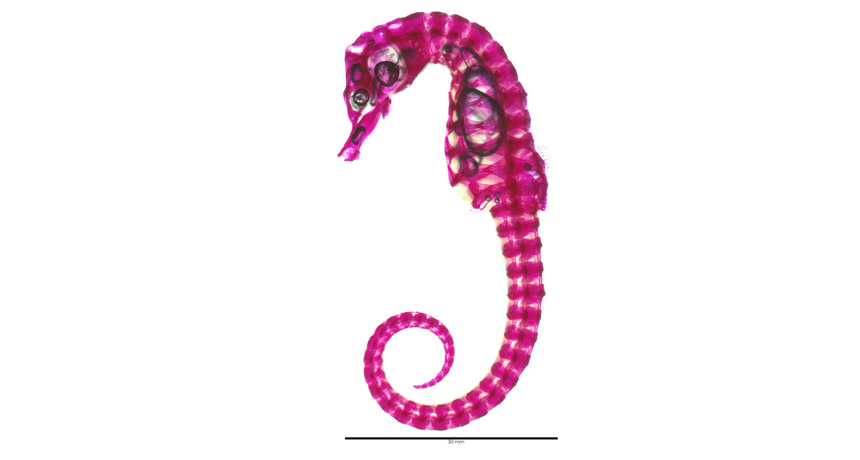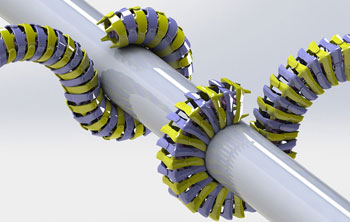Why seahorses have square tails
The shape is stronger and helps the fish grip things

The long flexible tails of seahorses (dye-stained skeleton of Hippocampus capensis shown) are made of square segments. They are a rare exception to the round tails of most other animals.
DOMINIQUE ADRIAENS, UGENT
Share this:
- Share via email (Opens in new window) Email
- Click to share on Facebook (Opens in new window) Facebook
- Click to share on X (Opens in new window) X
- Click to share on Pinterest (Opens in new window) Pinterest
- Click to share on Reddit (Opens in new window) Reddit
- Share to Google Classroom (Opens in new window) Google Classroom
- Click to print (Opens in new window) Print
By Susan Milius
The tail of a cat or dog is round, like a rope. In contrast, square segments make up the curving tail of the seahorse, a type of fish. Now, hammering and squishing 3-D printed replicas of these segments has revealed what’s so great about being square.
Bones hitched together in a flexible string of squares create protective cages. These cages are four times stronger than rounded ones, researchers reported July 3 in Science.
The skeleton of a seahorse tail is made of L-shaped bone pieces that fit together to make those squares. The squares line up in rows that decrease in size toward the tip of the tail. Muscles attached to the skeleton let the tail move and even grasp objects. To figure out why the rings were not round, Michael Porter, an engineer at Clemson University in South Carolina, and his colleagues turned to a 3-D printer. The team used the device to create a model of part of a seahorse tail. They made another one that was an engineer’s best estimate of what a round seahorse tail would look like.
Then the researchers squeezed the tails to test which gripped the best. They also hit the tails with a rubber mallet to test its strength. In both instances, the square tail won.

Scientists have determined from fossils that distant seahorse ancestors had armored tails. Those ancestors did not have grasping tails. Those tails would have benefited from such square protection. As seahorses evolved the ability to grip things with their tails, that square shape worked well, says Porter. Square segments press more surface area against a perch than do round ones. That gives squared tails better grip control.
Despite the advantages of the square shape, it’s a rare find in the animal world. As far as the researchers know, species in the seahorse family and some small chameleons are the only animals with square grasping tails instead of round ones.
Grasping tails of any kind are super rare among fishes. Out of some 30,000 kinds of fish, only seahorses and their close relatives called pipe horses can get a tail grip. Yet within the seahorse family, the rare fish tails that bend into a hook have evolved independently several times.
Using that tail, though, takes a seahorse a bit of time. Baby seahorses look like rice-grain-size adults. They have the shape but not the skills. That’s the sense that Dominique Adriaens has after watching some born in his lab at Ghent University in Belgium. Adriaens studies the evolution of animal shapes.
Baby seahorse tails look like grasping tails of adults, he says, but the babies don’t seem to get a grip — at first, anyway. Instead they float in seahorse herds near the water surface. Only when they’ve grown up more do they swim down to find a perch.
Power Words
(for more about Power Words, click here)
chameleon A type of lizard known for its ability to change the color of its skin.
engineer A person who uses science to solve problems. As a verb, to engineer means to design a device, material or process that will solve some problem or unmet need.
evolution A process by which species undergo changes over time, usually through genetic variation and natural selection. These changes usually result in a new type of organism better suited for its environment than the earlier type. The newer type is not necessarily more “advanced,” just better adapted to the conditions in which it developed.
fossil Any preserved remains or traces of ancient life. There are many different types of fossils: The bones and other body parts of dinosaurs are called “body fossils.” Things like footprints are called “trace fossils.” Even specimens of dinosaur poop are fossils. The process of forming fossils is called fossilization.
model A simulation of a real-world event (usually using a computer) that has been developed to predict one or more likely outcomes.
three-dimensional (3-D) printing The creation of a three-dimensional object with a machine that follows instructions from a computer program. The computer tells the printer where to lay down successive layers of some raw material, which can be plastic, metals, food or even living cells. 3-D printing is also called additive manufacturing.







